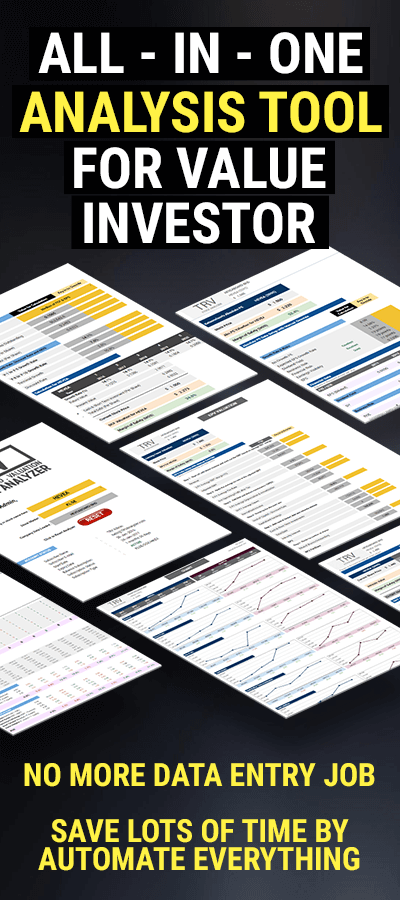Financial Dashboard (F – Dashboard) is the first go-to tab in the analyzer.
It provides a summary and important financial figures for the company. It is best to spend some time on this tab to determine if you should invest more time (or money) in the company.
Most of the items in this tab are pretty self-explanatory, except a few items that will be explained below.
This tab can be separated into two major parts:
1. Company Details and Important Financial Ratios
The top part of the page shows company details and important financial ratios. This will give a quick view of the company efficiency, solvency and also valuation. We will explain more on Star Rating, DCF Intrinsic Value Chart and Price CAGR below.
To access the full financial ratio, you may click on the link attached on the item. It will bring you to the page with a full 10 years’ financial ratio.
2. Simplified Financial Statements
The bottom part of the page shows a quick 5 financial years and trailing twelve months (TTM) simplifies financial statement.
To access the full financial statement, you may click on the link attached or click on “Statements” tab.
Stars Rating
The ultimate aim for every investor is to buy a quality stock that is growing at a good value. Hence, we try to rate every stock based on these 3 criteria – Quality, Value and Growth. A total of 5 stars is given for each criterion.
Quality of a stock is determined by looking into its Piotroski score, quality of earnings, ROIC, CROIC and debt level.
Value stars are given based on valuation ratios such as P/FCF, EV/EBIT, P/B and 7 valuation models which are calculated automatically by the analyzer.
Growth stars are awarded based on current and long-term growth rate of revenue, earnings and cash flow.
The details of how each star is given is listed below:
With the stars rating, you will get a feel of the stock fundamental immediately.
DCF Intrinsic Value Chart
DCF intrinsic value chart compares the current and past 10 years DCF valuations with the long term price chart. With this, you will immediately get a feel on how is the valuation of the stock. The stock is undervalued if the price is below the red line and overvalued if it is above it.
Price CAGR
There may be user who are not familiar with price CAGR. Price CAGR is the annualize price performance for the particular stock. It is calculated based on start and end point for the stock price ignoring the gyration in between.
Best way to illustrate Price CAGR is by looking at the price chart of the stock. Let’s take a look at an example – POHUAT.
Here we can see that for the past 1.1 year (from 31st Oct 2016 to 21st Dec 2017), if you been holding POHUAT shares, your CAGR including dividend is 13.8% per annum.









![[User Guide] TRV Stock Analyzer Overview](https://trvanalyzer.com/wp-content/uploads/2017/09/Tutorial-Header-Overview-Tabs-500x383.png)
![[User Guide] “Home” Tab](https://trvanalyzer.com/wp-content/uploads/2017/09/Tutorial-Header-Home-Tab-500x383.png)
![[User Guide] “Statements” Tab](https://trvanalyzer.com/wp-content/uploads/2017/12/Tutorial-Header-Statements-500x383.png)

Leave A Comment